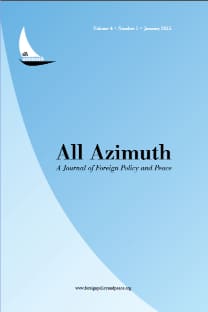An Inter-Subsystemic Approach in International Relations
An Inter-Subsystemic Approach in International Relations
System, strategic culture, subsystem, crisis change,
___
- Binder, Leonard. “The Middle East as Subordinate International System.” World Politics 10 (April 1958): 408-29.
- Boulding, Kenneth E. World as a Total System. London: Sage Publications, 1985.
- Brams, Steven J. “Transaction Flows in the International System.” The American Political Science Review 60 (December 1966): 880-98.
- Brecher, Michael. “International Relations and Asian Studies: The Subordinate State System of Southern Asia.” World Politics 15 (January 1963): 213-35.
- Brecher, Michael, and Hemda Ben Yehuda. “System and Crisis in International Politics.” Review of International Studies 11 (January 1985): 17-36.
- Brecher, Michael, and Patrick James. Crisis and Change in World Politics. Boulder, Colorado: Westview Press, 1986.
- Buzan, Barry. “The English School as a New Systems Theory of World Politics.” In New Systems Theories of World Politics, edited by Mathias Albert, Lars-Eric Cederman, and Alexander Wendt, 195-219. New York: Palgrave, 2010.
- Buzan, Barry, and Matthias Albert. “Differentiation: A Sociological Approach to International Relations Theory.” European Journal of International Relations 16, no. 3 (September 2010): 315-37.
- Buzan, Barry, and Richard Little. International Systems in World History. Remaking the Study of International Relations. Oxford: Oxford University Press, 2000.
- Christensen, Thomas J. “Conclusion: System Stability and the Security of the Most Vulnerable Significant Actor.” In Coping with Complexity in International System, 329-56. Boulder, Colorado: Westview Press, 1993.
- Cooper,Robert. “Post-Modern State and the New World Order.” Demos (2000).
- Deutsch, Karl W., and J. David Singer. “Multipolar Power Systems and International Stability.” World Politics 16 (April 1964): 390-405.
- Donnely, Jack. “The Elements of the Structures of International Systems.” International Organization 66, no. 4 (October 2012): 609-43.
- Genco, Stephen J. “Integration Theory and System Change in Western Europe: The Neglected Role of Systems Transformation Episodes.” In Change in the International System, edited by Ole R. Holsti, Randolph M. Siverson, and Alexander L. George, 55-80. Boulder, Colorado: Westview Press, 1980.
- Gray, Colin. “Strategic Culture as Context: the First Generation of Theory Strikes Back.” Review of International Studies 25, no. 1 (January 1999): 49-69.
- Hermann, Charles F., and Robert E. Mason. “Identifying Behavioral Attributes of Events That Trigger International Crises.” In Change in the International System, edited by Ole R. Holsti, Randolph M. Svenson, and Alexander L. George, 189-210. Boulder, Colorado: Westview Press, 1980.
- Hoffmann, Stanley. “Discord in Community.” International Organization 17 (Summer 1963): 521-49.
- Hopmann, P. Terrence, and Timothy D. King. “From Cold War to Détente: The Role of the Cuban Missile Crisis and the Partial Nuclear Test Ban Treaty.” In Change In the International System, edited by Ole R. Holsti, Randolph M. Svenson, and Alexander L. George, 163-88. Boulder, Colorado: Westview Press, 1980.
- Huntington, Samuel. The Clash of Civilizations and the Remaking of World Order. New York: Touchstone, 1996.
- Johnston, Alastair Iain. “Thinking about Strategic Culture.” International Security 19, no. 4 (Spring 1995): 32-64.
- Kaplan, Morton A. System and Process in International Politics. New York: John Wiley & Sons, 1957.
- Keohane, Robert O., and Joseph S. Nye. Power and Interdependence. New York: Longman, 2001.
- Lawson, Stephanie, ed. The New Agenda for International Relations. Cambridge: Polity Press, 2002.
- Lindberg, Leon, and Stuart Scheingold. Europe’s Would-be Polity: Patterns of Change in the European Community. Prentice Hall, 1970.
- Modelski, George. “International Relations and Area Studies: The Case of Southeast Asia.” International Relations 2 (April 1961): 143-55.
- --. “Is World Politics Evolutionary Learning?” International Organization 44, no. 1 (Winter 1990): 1-24.
- Nayak, Meghana, and Eric Selbin. Decentering International Relations. New York: Zed Books, 2010.
- Organski, A. F. K. “The Power Transition.” In International Politics and Foreign Policy. A Reader in Research and Theory, edited by James Rosenau, 367-75. New York: The Free Press, 1961.
- Özdemir, Haluk. Avrupa Mantığı: Avrupa Bütünleşmesinin Teori ve Dinamikleri. İstanbul: Boğaziçi Üniversitesi Yayınları, 2012.
- -- . “Türkiye’nin ‘Sınır-Ülke’ Niteliği: Farklı Stratejik Kültürler Arasında Türk Dış Politikası.” Avrasya Etüdleri 33, no. 1 (2008): 7-46.
- Rasler, Karen, and William R. Thompson. “Systemic Theories of Conflict.” In Guide to the Scientific Study of International Processes, edited by Sara McLaughlin Mitchell, Paul F. Diehl, and James D. Morrow, 93-114. West Sussex: Wiley-Blackwell, 2012.
- Rosenau, James. “The Functioning of International Systems.” Background 7, no. 3 (November 1963): 111-17.
- Singer, David. “The Global System and its Subsystems: A Developmental View.” In Linkage Politics-Essays on the Convergence of National and International Systems, edited by James N. Rosenau, 21-43. New York: The Free Press, 1969.
- Singer, J. David, and Melvin Small. The Wages of War, 1816-1965. A Statistical Handbook. New York: John Wiley and Sons, 1972.
- Thompson, William R. “TheRegional Subsystem: A Conceptual Explication and a Propositional Inventory.” International Studies Quarterly 17 (March 1973): 89-117.
- Walt, Stephen M. The Origins of Alliances. Ithaca&London: Cornell, 1987.
- Waltz, Kenneth N. “Realist Thought and Neorealist Theory.” Journal of International Affairs 44, no. 1 (1990): 21- 37.
- -- . “The Stability of a Bipolar World.” Daedalus 93 (Summer 1964): 881-909.
- -- . Theory of International Politics. New York: McGraw Hill, 1979.
- Zinnes, Dina A. “Prerequisites for the Study of System Transformation.” In Change in the International System, edited by Ole R. Holsti, Randolph M. Siverson, and Alexander L. George, 3-21. Boulder, Colorado: Westview Press, 1980.
- ISSN: 2146-7757
- Yayın Aralığı: 2
- Başlangıç: 2012
- Yayıncı: Dış Politika ve Barış Araştırmaları Merkezi, İhsan Doğramacı Barış Vakfı
Knowledge, Repetition and Power in Ibn al-‘Arabi’s Thought: Some Preliminary Comments on Methodology
Transatlantic Security, Defence and Strategy: Badly Needed Reforms
Transatlantic Security, Defence and Strategy: Badly Needed Reforms*
Interpreting Turkey's Middle East Policy in the Last Decade*
Interpreting Turkey’s Middle East Policy in the Last Decade
Knowledge, Repetition and Power in Ibn al- Arabi's Thought: Some Preliminary Comments on Methodology
International Relations Theories and Turkish International Relations: Observations Based on a Book
